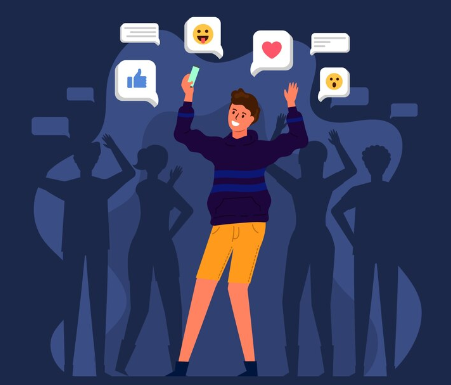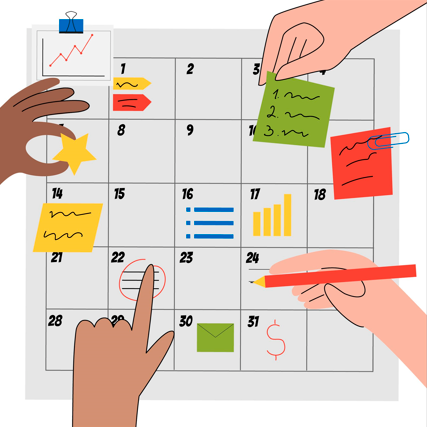Beyond the Like Button: A Step-by-Step Guide to Sharing Multimedia Content
In today's digital landscape, sharing multimedia content has become an essential part of our daily lives. With 25.1 million hours being spent online globally and 41.6 million WhatsApp messages sent, it’s no wonder that online media consumption has become insatiable. Whether it’s a photo on Instagram, a video on YouTube, or a podcast episode on Spotify, we all want our creations to reach as many people as possible. While getting likes and followers is great, it’s not enough to ensure that your content gets seen by the right audience.
Instant messaging apps provide the ability to share various types of multimedia content effortlessly. You can send photos, videos, documents, voice messages, or even your location within seconds. This feature enhances communication and allows for richer, more interactive conversations. It’s fundamental to experiment with different sharing strategies to find what works best for you. Engaging with content has become a nuanced practice, especially as we seek to create deeper connections and convey messages with more influence.
Multimedia content—videos, podcasts, infographics, and images—offers an enriched way to share your ideas and connect with your audience. Interestingly, YouTube is used by 83% of adults in the US, making it the most widely used online social platform. Coming a close second after the giant is Face Book with 68% of adults in the United States sharing, liking and connecting on the platform daily. With an average of 47%, Instagram is in the third spot amongst adults although having over 1 billion active accounts on a month-to-month basis. Tik Tok has shown steady substantial growth, stemming from just 21% in 2021 to 33%, it has become more and more popular with individuals over the age of 18. With a difference in the ethnic demographic, WhatsApp is more popular with Hispanic adults coming at 54% and not so popular with Asian adults with only 51% of them using it on a daily basis. Pinterest usage has a significant gender gap with women showing 50% interest in using it over the 19% shown by their male counterparts. Being a ‘new kid on the social media block’ only being launched in 2020, BeReal which is a photo sharing platform is only being consumed by 3% of adults.
This blog post aims to provide readers with a comprehensive guide on how to share multimedia content beyond just clicking the like button. We will explore the steps of beneficially sharing your content, while emphasizing the value of creating content that resonates with the target audience and provides empirical advice on how to do so.
Step 1: Define Your Goals
Before you start sharing your content, it’s crucial to define your goals. Are you trying to increase brand awareness, drive traffic to your website, or generate leads? Knowing what you want to achieve will help you create a strategy and select the appropriate platforms to share your content. Having specific goals will help you focus your content creation and sharing strategy.
- Increasing brand awareness: If an individual's goal is to increase brand awareness, they might share behind-the-scenes photos or videos showcasing their brand's personality and values. They could also share industry news and insights, positioning themselves as thought leaders in their field.
- Driving traffic to a website: If driving traffic to a website is the goal, individuals may share teaser content that encourages users to click through to their site. This could include promotional graphics, short videos, or infographics highlighting key features of their products or services.
- Showcasing a product or service: To showcase a product or service, individuals can share detailed images or videos demonstrating its features and benefits. They can also share customer testimonials, case studies, or user-generated content showcasing how others have benefited from the product or service.
Step 2: Know Your Audience
Before you create or share any multimedia content, it’s essential to understand your audience. Who are they? What do they care about? What platforms do they use? Tailoring content to your audience's preferences ensures greater engagement. Use insights from social media analytics and surveys to identify trends and interests. Identify which platforms they use, when they are most active on those platforms, and the types of content they engage with. This information will help you determine the best time to share your multimedia content.
Step 3: Choose the Right Platforms
Not all social media platforms are created equal. Each one has its own unique features, audience demographics, and best practices. You need to choose the platforms that align with your goals and where your target audience spends their time. For example, if you’re a B2B company, LinkedIn might be a better option than Instagram. Different social media platforms have varying audience expectations and engagement styles. These are the various platforms, and the type of content mostly expected:
- Facebook: Videos should be short and captioned; infographics should have clear, striking visuals.
- Instagram: Prioritize high-quality images and engaging short videos through Reels.
- X (formerly Twitter): Share snippets of your multimedia with direct links, ensuring that headlines are catchy.
- LinkedIn: Share professional insights through infographics or long-form video content tailored for business audiences.
Tailoring your content to specific platforms maximizes its impact.
Step 4: Choose the Right Multimedia Format
Different types of content serve different purposes. In line with step 3, you also need to ensure that the format is optimal with the platform you have chosen. Here’s a quick overview of popular formats:
- Videos: Great for storytelling or tutorials as they offer an engaging way to communicate complex information.
- Podcasts: Share interviews, discussions, or educational content on-the-go which is ideal for users who prefer audio consumption.
- Infographics: Present data or processes visually which is perfect for those who need quick, digestible information.
- Images: Often the most straightforward way to evoke emotion and tell a story immediately.
Choosing a format that aligns with your message and resonates with your audience can have a significant impact on the likes that you receive.
Step 5: Optimize Your Content
Once you’ve chosen the right platforms, it’s time to optimize your content for each one. This includes creating visually appealing graphics, writing compelling descriptions, and using relevant keywords and hashtags. Remember, different platforms have different character limits and image sizes, so you’ll need to tailor your content accordingly. For example, Instagram Stories have different dimensions than YouTube videos, so you’ll need to create separate versions of the same content for each platform. These differences highlight how each platform is tailored to different types of content consumption and user engagement. Additionally, use relevant keywords and hashtags to increase visibility.
Here are some key tips for creating compelling content:
- Plan and Script: For videos and podcasts, scripting can help in organizing thoughts. Outline key messages you want to convey.
- Invest in Tools: Use quality cameras, microphones, or design software. There are many free and affordable options available. For video editing you can use software like Shotcut which ensures that there is no watermark in your final video edit when you publish.
- Edit Thoughtfully: Whether it’s video editing software or graphic design apps like Canva or Design Wizard, take the time to refine your content to keep it polished and professional.
Step 6: Create a Sharing Schedule
It’s better to start small and gradually increase frequency rather than trying to post too much too soon. Consistency is key when it comes to sharing multimedia content. However, be careful to be mindful of the quality over quantity rule when contemplating when and what to share. Creating a sharing schedule will help ensure that you post regularly and reach your audience at prime times. There are peak engagement times, generally from Tuesdays through Thursdays between 9 a.m. and 2 p.m., varying slightly by platform.
Use a content calendar to plan out your multimedia content in advance. This will help ensure that you have enough content to share regularly and that your content is diverse. Use online tools to assist you to plan and schedule your posts in advance. One example you can use is ClickUp which offers flexible templates, task managers and to-do lists to assist you accomplish your goals with ease and keep you accountable.
Step 7: Engage with Your Audience and Encourage Feedback
Sharing multimedia content isn’t a one-way street, engagement is a two-way street. Once you’ve posted your content, don’t just walk away, engage with your audience by responding to comments and messages. This will help build relationships and increase the chances of your content being shared organically.
- Ask Questions: Encourage commentary to create a dialogue. For example, “What do you think about this?”
- Monitor Comments: Respond to feedback, both positive and negative, to show you value your audience’s input.
- Create Polls or Quizzes: Use interactive content to gather opinions and insights, further enhancing engagement. These are fun and engaging, and they can provide valuable insights into your audience's preferences and behaviors.
Step 8: Measure Your Success
The final step is to measure your success and analyze your results. Use the analytics tools provided by each platform to see how your content is performing. This will help you identify what’s working and what’s not, so you can adjust your strategy accordingly. Be ready to ditch what didn’t work and stick with what appeals to your audience. Use this data to adjust future content strategies accordingly.
- Engagement Rates: Likes, shares, comments, and saves give insight into how audiences are responding.
- Reach and Impressions: Identify how many people are seeing your content and how effective your sharing strategies are.
Sharing multimedia content is an art form that requires strategy and planning. By following these steps, you can increase the visibility of your content and connect with your target audience on a deeper level. Remember, success doesn’t happen overnight, but with consistency and perseverance, you can become a master.
By defining your goals and understanding your audience while choosing the appropriate platform and format, it will assist you to create quality impactful content. Optimize each platform by engaging meaningfully with your audience and analyzing the performance of what you have created. You can create impactful multimedia experiences that resonate deeply with your audience. Remember, the key to effective sharing lies in making a meaningful connection—fostering relationships through engaging and thoughtful content. Embrace these steps, and watch your communications flourish!






